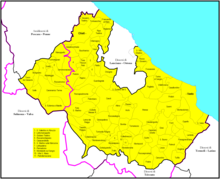Roman Catholic Archdiocese of Chieti-Vasto
This article needs additional citations for verification. (January 2016) |
Archdiocese of Chieti-Vasto Archidioecesis Theatina-Vastensis | |
|---|---|
 | |
| Location | |
| Country | |
| Ecclesiastical province | Chieti-Vasto |
| Statistics | |
| Area | 2,539 km2 (980 sq mi) |
| Population - Total - Catholics (including non-members) | (as of 2006) 312,982 305,882 (97.7%) |
| Parishes | 157 |
| Information | |
| Denomination | Catholic Church |
| Rite | Roman Rite |
| Established | 6th Century |
| Cathedral | Chieti Cathedral (Cattedrale di S. Giustino (Chieti)) |
| Co-cathedral | Vasto Cathedral (Concattedrale di S. Giuseppe (Vasto)) |
| Current leadership | |
| Pope | Francis |
| Archbishop | Bruno Forte |
| Map | |
 | |
| Website | |
| www.webdiocesi.chiesacattolica.it | |
The Italian Catholic Archdiocese of Chieti-Vasto (Latin: Archidioecesis Theatina-Vastensis) received that name in 1986. The historic Archdiocese of Chieti was elevated from a diocese in 1526.[1][2]
History[]
This section needs expansion with: any historical facts, e.g. Guelphs and Ghibbelines. You can help by . (October 2016) |
Chieti is the ancient Teate. In the Gothic War it was captured by Totila; later it fell into the hands of the Lombards, from whom it was captured by Pepin and devastated. The Normans rebuilt the city, which thenceforth belonged to the Kingdom of the Two Sicilies.
Saint Justinus is venerated as the first Bishop of Chieti, and the cathedral is dedicated to him. Several of his successors are also venerated as saints, among them (874), whose portrait is on the bronze doors of the monastery of St. Clement in the .
Giovanni Pietro Caraffa in 1524 resigned the see, and associated himself with Cajetan of Tiene in the foundation of the Theatine Order. Later Caraffa became pope under the name of Paul IV.
Bishops and Archbishops[]
- Teodorico I (c. 840)
- Lupo I (c. 844)
- Pietro I (c. 853)
- Teodorico II (c. 880)
- Atinolfo (c. 904)
- Rimo (c. 962)
- Liudino (c. 965)
- Lupo II (c. 1008)
- Arnolfo (c. 1049)
- Attone I (1056–1073)
- Celso (1073–1078)
- Rainolfo (1085–1105)
- Ruggero
- Guglielmo I (1107–1117)
- Andrea I (1118)
- Gerardo (1118–1125)
- Attone II (1125–1137)
- Rustico (1137–1140)
- Alanno (1140–1150)
- Andrea II (1150–1190)
- Pietro II (1191)
- Bartolomeo (1192–1227)
- Rainaldo (1228–1234)
- Gregorio di Poli (1234–1251)
- Landolfo Caracciolo (1252–1253)
- Alessandro di Capua (1253–1262)
- Nicola da Fossa, O.Cist. (1262–1282)
- Tommaso (1282–1294)
- Guglielmo II ? (1292–1293)
- Rainaldo, O.P. (1295–1303)
- Mattia (1303)
- Pietro III (1303–1320)
- Raimondo de Mausaco, O.Min. (1324–1326)
- Giovanni Crispano de Rocca (1326–1336)
- Pietro Ferri (1336)
- Beltramino Paravicini (1336–1339)
- Guglielmo III Capoferro (1340–1352)
- Bartolomeo Papazzurri, O.P. (1353–1362)
- Vitale da Bologna, O.S.M. (1363–1373)
- (1373–1378)
- Giovanni de Comina (1378–1396)
- Guglielmo Carbone (1396–1418)
- Nicola Viviani (1419–1428)
- Marino de Tocco (1429–1438)
- Giovanni Battista della Buona (1438–1445)
- Colantonio Valignani (1445–1488)
- (1488–1497)
- (1497–1499)
- Oliviero Carafa (administrator of the see, 1499–1501)
- (1501–1505)
- Gian Pietro Carafa (1505–1518), then archbishop of Brindisi
- Gian Pietro Carafa (administrator of the see, 1518–1524)
- (1524–1527), antibishop from 1526
- Guido de' Medici (1528–1537)
- Gian Pietro Carafa (1537–1549), then archbishop of Naples
- Bernardino Maffei (1549–1553)
- Marcantonio Maffei (1553–1568)
- Giovanni Oliva (1568–1577)
- Girolamo Leoni (1577–1578)
- Cesare Busdragus (1578–1585)
- (1585–1591)
- Orazio Sanminiato (1591–1592)
- Matteo Sanminiato (1592–1607)[3]
- Anselmo Marzato, O.F.M.Cap. (1607–1607)[3]
- Orazio Maffei (1607–1609)[3]
- Ulpiano Volpi (1609–1615)[3]
- Paolo Tolosa, C.R. (1616–1618)[3]
- Marsilio Peruzzi (1618–1631)[3]
- (1631–1638), then archbishop of Urbino[3]
- Stefano Sauli (1638–1649)[3]
- Vincenzo Rabatta (1649–1654)[3]
- Angelo Maria Ciria, O.S.M. (1654–1656)[3]
- Modesto Gavazzi, O.F.M.Conv. (1657)[3]
- Niccolò Radulovich (1659–1702)[3]
- Vincenzo Capece (1703–1722)
- Filippo Valignani, O.P. (1722–1737)
- Michele Palma (1737–1755)
- Nicola Sanchez De Luna (1755–1764), then bishop of Nola
- Francesco Brancia (1765–1770)
- Luigi del Giudice, O.S.B.Coel. (1770–1792)
- Andrea Mirelli, O.S.B.Coel. (1792–1795)
- Francesco Saverio Bassi, O.S.B.Coel. (1796–1821)
- Carlo Maria Cernelli (1822–1838)
- Giosuè Maria Saggese, C.SS.R. (1838–1852)
- Michele Manzo (1852–1856)
- Luigi Maria de Marinis (1856–1877)
- Fulco Luigi Ruffo-Scilla (1877–1887)
- , O.F.M. Cap. (1887–1901)
- Gennaro Costagliola, C.M. (1901–1919)
- (1919–1929), then archbishop of Salerno
- Giuseppe Venturi (1931–1947)
- Giovanni Battista Bosio (1948–1967)
- Loris Francesco Capovilla (1967–1971)
- Vincenzo Fagiolo (1971–1984)
- Antonio Valentini (1984–1993)
- Edoardo Menichelli (1994–2004), then archbishop of Ancona-Osimo
- Bruno Forte (from 2004)
Notes[]
- ^ Cheney, David M. "Archdiocese of Chieti-Vasto". Catholic-Hierarchy.org. Retrieved June 16, 2018.self-published
- ^ Chow, Gabriel. "Archdiocese of Chieti-Vasto". GCatholic.org. Retrieved June 16, 2018.self-published
- ^ Jump up to: a b c d e f g h i j k l Gauchat, Patritius (Patrice). HIERARCHIA CATHOLICA MEDII ET RECENTIORIS AEVI Vol IV. p. 332.
External links[]
![]() This article incorporates text from a publication now in the public domain: Herbermann, Charles, ed. (1913). Catholic Encyclopedia. New York: Robert Appleton Company. Missing or empty
This article incorporates text from a publication now in the public domain: Herbermann, Charles, ed. (1913). Catholic Encyclopedia. New York: Robert Appleton Company. Missing or empty |title= (help)
- Roman Catholic dioceses in Abruzzo
- Dioceses established in the 6th century
- Archbishops of Chieti
- Chieti
